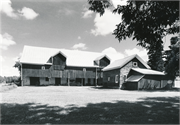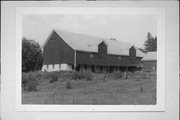Property Record
LINCOLN DR, N SIDE, .3 M W OF BERLIN LN
Architecture and History Inventory
| Historic Name: | August and Henrietta Seefeld Barn |
|---|---|
| Other Name: | |
| Contributing: | |
| Reference Number: | 25521 |
| Location (Address): | LINCOLN DR, N SIDE, .3 M W OF BERLIN LN |
|---|---|
| County: | Marathon |
| City: | |
| Township/Village: | Berlin |
| Unincorporated Community: | |
| Town: | 30 |
| Range: | 6 |
| Direction: | E |
| Section: | 21 |
| Quarter Section: | SE |
| Quarter/Quarter Section: | SE |
| Year Built: | 1900 |
|---|---|
| Additions: | |
| Survey Date: | 1978 |
| Historic Use: | barn |
| Architectural Style: | Side Gabled |
| Structural System: | |
| Wall Material: | Board |
| Architect: | |
| Other Buildings On Site: | |
| Demolished?: | No |
| Demolished Date: |
| National/State Register Listing Name: | Not listed |
|---|---|
| National Register Listing Date: | |
| State Register Listing Date: |
| Additional Information: | Forebay barns--often called Pennsylvania, Pomeranian, or Wisconsin porch barns--are a special type of bank or basement barn associated with German immigrants. In Wisconsin, examples cluster in Marathon, Lincoln, Ozaukee, and Green counties. Among basement barns, the forebay barn was distinctive. Its characteristic "forebay," or overshot, a second-floor extension, jutted out over the barnyard to protect the cattle doors below from snow drifts and to provide an open-air shelter for the cows. The forebay also allowed the farmer to pitch hay from the mow to the barnyard below without blocking the cattle doors. Usually constructed on the south or southeast face of the barn, the forebay also incorporated an early type of passive-solar design: in winter, it allowed the low sun to warm the stables, and yet it provided cooling shade when the summer sun was high overhead. The forebay barn’s origin has been the subject of a lively scholarly debate. Some argue that German immigrants developed the design while living in Pennsylvania and that it spread westward from there; others argue that immigrants brought the design directly from Europe, where prototypes were once commonplace. All these examples in Marathon County were built by German immigrants, so it seems most likely that their design comes from German precedent rather than the somewhat different barns built in Pennsylvania Dutch country. These forebay barns are often referred to as "Wisconsin porch barns." Each consists of a gable-roofed, two-story barn with a raised fieldstone basement and a haymow constructed of vertical wooden siding. Their deep forebays are framed independently from the rest of the structure and are supported by posts, unlike the cantilevered structures found in Pennsylvania and in Green County, Wisconsin. Almost all the barns also have at least one gabled wall-dormer on the forebay side, which allowed greater ventilation and sheltered the door through which the farmer pitched the hay. |
|---|---|
| Bibliographic References: | Buildings of Wisconsin manuscript. |
| Wisconsin Architecture and History Inventory, State Historic Preservation Office, Wisconsin Historical Society, Madison, Wisconsin |


